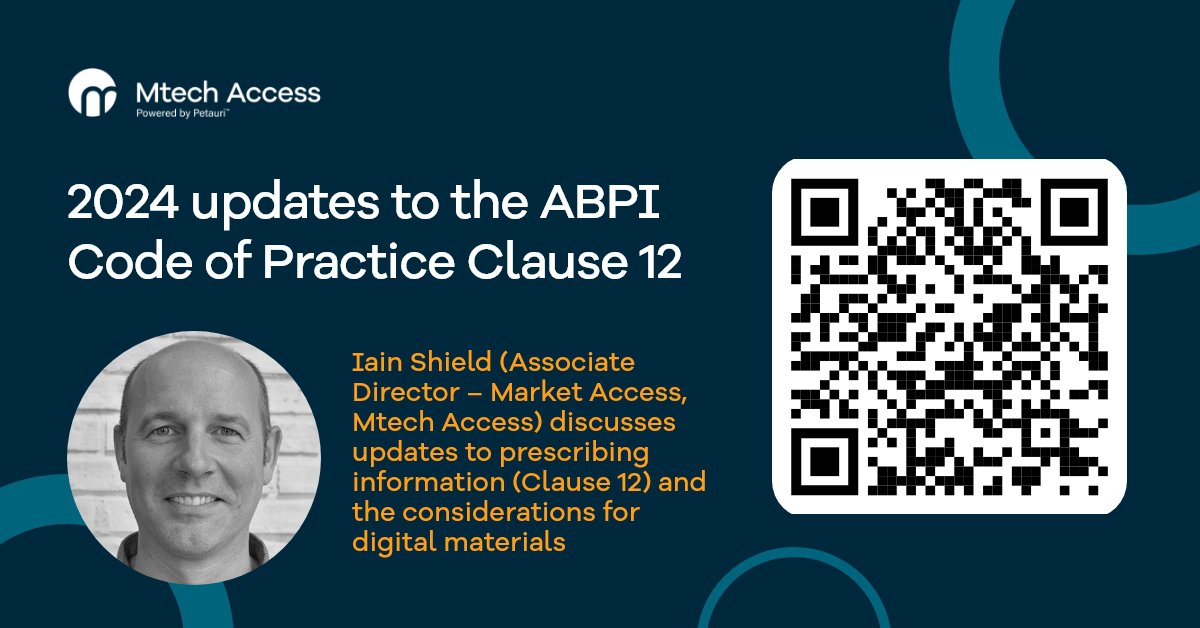
Iain Shield (Associate Director – Market Access, Mtech Access) has reviewed the changes to the ABPI Code of Practice, and highlights updates to prescribing information (Clause 12) and considerations around QR codes for digital communication materials.
On 23rd September, the ABPI released an updated Code of Practice. Their last release was in 2021, and this latest update has been much anticipated. There are no track changes of what has been updated and so you will need to be proactive to learn what has changed, how it impacts your materials, and how fast you need to react.
We knew an update was coming, but we didn’t know precisely when. With >3,000 comments on their initial consultation (including from me!), the Prescription Medicines Code of Practice Authority (PMCPA) have done well to consider the views, publish the update this year, and end the uncertainty.
As far as timescales go, failure to comply with new requirements will not constitute a breach between 1st October 2024 (when the new code comes into effect) and the end of the year. However, from 1st January 2025, it will.
Updates to prescribing information (Clause 12)
As with previous iterations, prescribing information must be part of and easily accessible from promotional material. It can be challenging, however, to find a place for prescribing information and links or buttons to it within visually engaging materials. We have always found creative and compliant solutions for prescribing information placement in digital tools. The new code aims to provide new clarity and further options.
The PMCPA have communicated that Clause 12 has been completely re-written and, after the first sentence of 12.1 (which is identical), changes start emerging.
It is interesting that the sentence “The prescribing information must form part of the promotional material and must not be separate from it” is omitted in the new version of the code. Indeed, the new code goes as far as to say that digital material used for in-person meetings could have the prescribing information made available as a printed document (with the digital material referring directly to this). In the new version of the code, prescribing information can be separated from the material in certain circumstances.
Clause 12.1 sets out 3 scenarios in relation to promotional materials being used in the following contexts:
- Printed material
- Digital material accessed by a recipient on their own device
- Digital material shown to a recipient in person on a company device
Focusing on digital materials, for those accessed by a recipient on their own device, the code allows companies to include prescribing information as text, by way of a clear and prominent, direct, single-click link.
For digital materials shown to a recipient in person on a company device, the code now allows for two further options. The first option is for a clear and prominent ‘quick response’ (QR) code with instructions to scan it for the prescribing information. The second option is to provide prescribing information in a printed document, which must be referred to in the digital material.
Using a QR code for prescribing information
The QR code was invented 30 years’ ago, and, in its most basic form, enables your smart device camera to detect a URL to which you can then navigate. QR codes are commonly used across marketing and promotion for many industries.

What seems to change with this QR option is onus of responsibility. If your audience doesn’t have a smart device (or they left it in another room, or their camera doesn’t work, or their battery life is low!) then there won’t be a way to access the prescribing information.
Will this constitute a breach? Will the QR code approach carry an additional risk, and will signatories embrace or reject this change? Ultimately, might your audience wish to access prescribing information but not be able to? If you think the QR option brings an answer of ‘maybe’, then perhaps consider another method in addition, such as a paper copy that is referred to in the digital material. On the positive side, the QR code enables the prescribing information to be hosted centrally, away from the promotional material, enabling updates to it that don’t necessarily mean an update to the promotional material itself. This is a useful change in the new code.
Wider ABPI Code changes and opportunities to learn more
Do note, there are many changes across the code. The changes to Clause 12 that I have highlighted are just one aspect of the update. You can read more about the new code here.
During October, there will be three ABPI-run on-demand webinars explaining the changes to the code: check the ABPI website for details.
To explore the impact of these changes on your promotional materials and the new options for placement of prescribing information, email info@mtechcaccess.co.uk.


